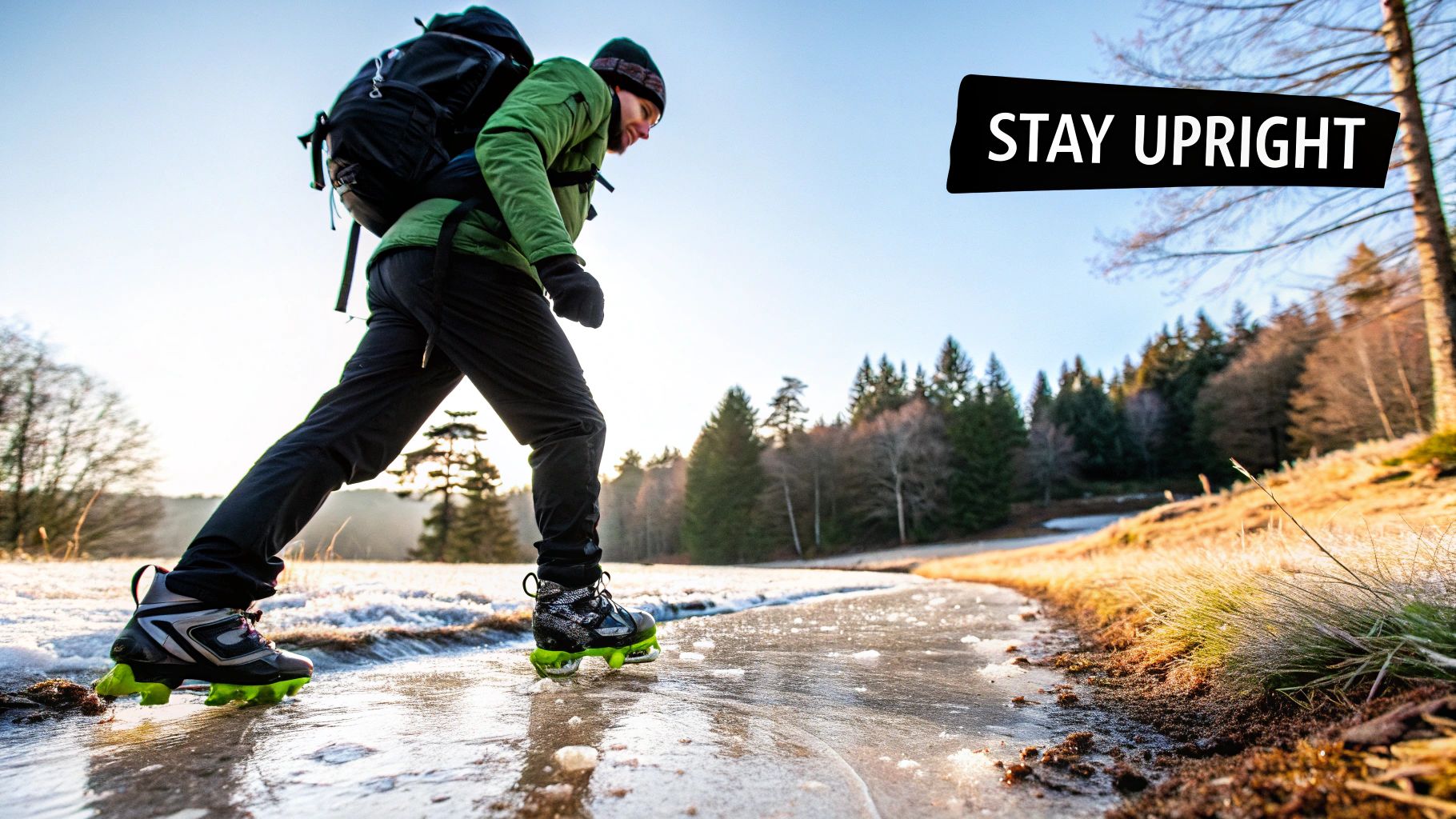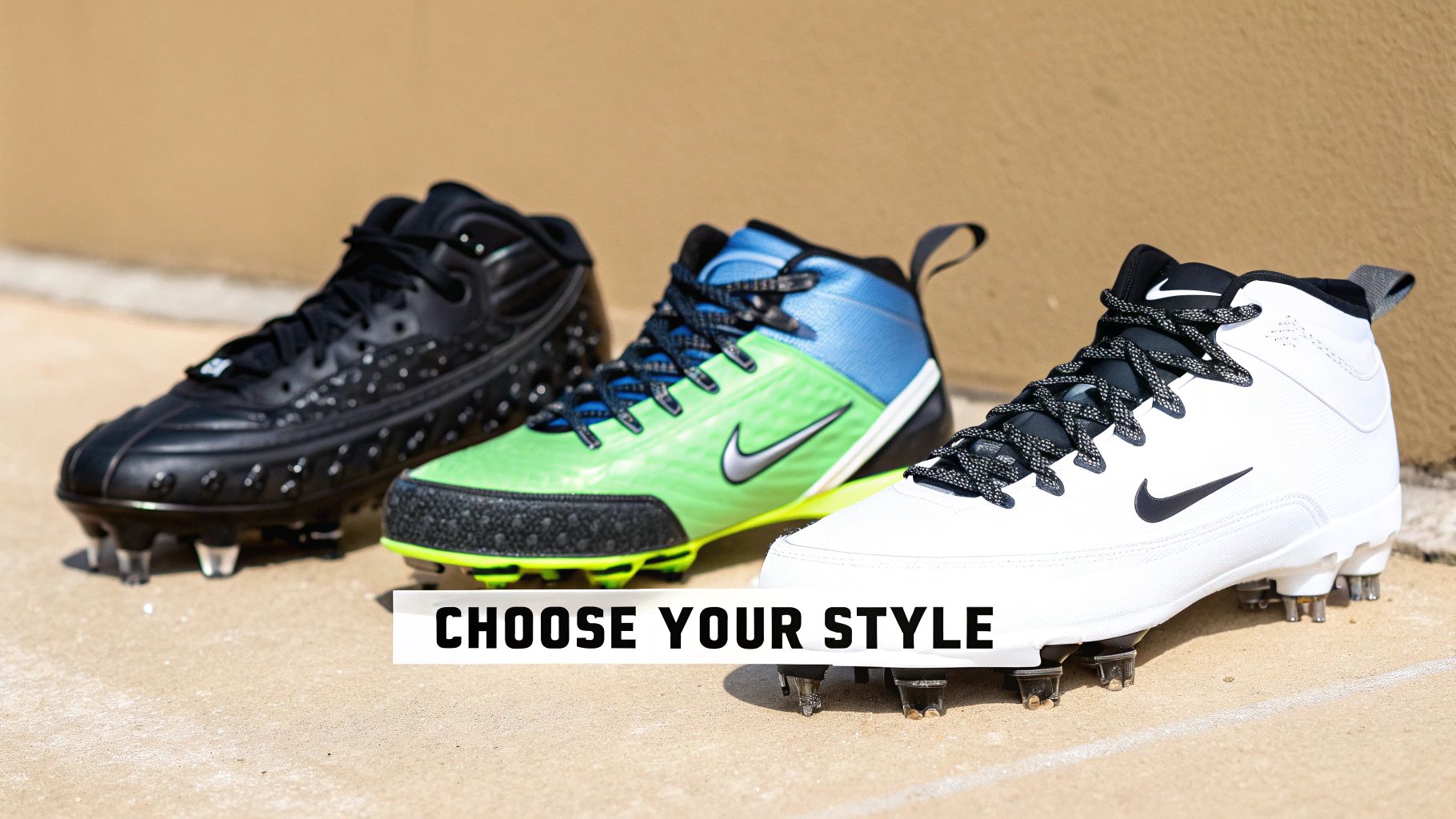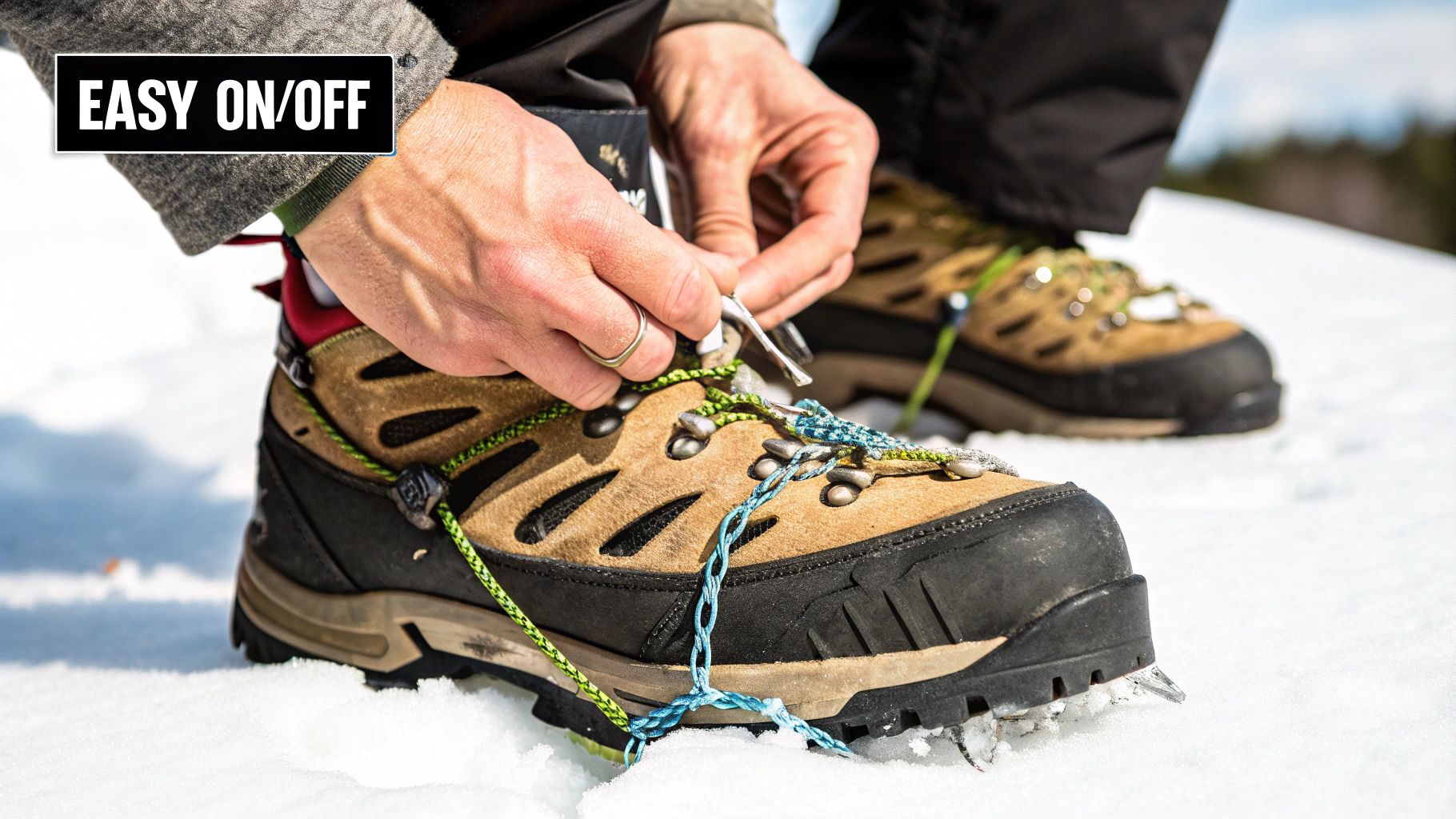With over 10,000 orders
With over 10,000 orders

Photo by Fidel Fernando on Unsplash
We've all been there. That one slick, unavoidable patch of ice on the sidewalk that turns a simple walk into a heart-stopping moment of fear.
This is exactly why ice shoe cleats are so much more than a winter accessory. Think of them as winter tires for your feet—an essential safety tool that gives you a confident footing when conditions are at their absolute worst.

You wouldn't try to drive your car on a frozen road with summer tires, right? The lack of grip makes every turn and stop a total gamble. That’s precisely what you're doing when you wear regular shoes on ice.
Ice shoe cleats fix this problem by giving you the aggressive traction needed to bite into frozen surfaces. They transform treacherous ground into a completely walkable path.
And they aren't just for extreme adventurers scaling icy peaks. These devices are for everyday people who simply want to get through the winter safely.
Just think about your own winter routine. Ice shoe cleats offer that crucial stability in so many common situations, turning moments of high risk into confident strides.
You can really see their value when you look at daily life:
The core benefit is simple but incredibly profound: ice shoe cleats drastically reduce your risk of a slip-and-fall injury. They empower you to move freely and without fear, helping you maintain your independence and active lifestyle all winter long.
This growing focus on personal safety is something we're seeing in market trends, too. The global demand for these traction aids is expanding as more people recognize their value. The ice cleat market was recently estimated at around USD 150 million, with forecasts projecting serious growth to USD 250 million by 2033. This shows a clear shift toward prioritizing safety during icy weather. You can find out more about the ice cleat market growth and trends.
Ultimately, buying a quality pair of ice shoe cleats is an investment in your own well-being. It’s about replacing that winter anxiety with solid assurance, one secure step at a time.

The magic that keeps you from slipping and sliding on a sheet of ice isn't really magic at all. It's just simple, effective physics. The secret lies in two key principles: pressure and friction. In a clever twist, your own body weight—the very thing that makes ice so treacherous—becomes the tool that gives you a solid footing.
Think about it like this: if you tried to press a thumbtack into a wooden board with the palm of your hand, you wouldn't get very far. It's just not enough focused force. But when you push on the tack's tiny head with your thumb, all that same energy is concentrated onto one sharp point, and it sinks right in.
That’s exactly how ice cleats work. The metal spikes or coils take your entire body weight and focus it onto a few small, aggressive points. This immense pressure allows the spikes to bite down into the ice or hard-packed snow, breaking through that slippery top layer. Instead of your boot sole hydroplaning over the surface, the cleats create dozens of tiny anchor points, generating the friction you need to walk confidently.
Every pair of ice cleats, no matter the style, is built with a two-part system that works in perfect harmony. Once you understand the role of each part, you can see why they’re so reliable.
The Harness: This is the flexible, stretchy cage that fits over your boot. It’s usually made from a tough elastomer or high-grade rubber designed to stay pliable even in sub-zero temperatures. A good harness is crucial—it's what holds the whole system securely to your footwear, so it doesn't slip, shift, or fall off when you're on the move.
The Traction Elements: These are the business end of the cleat. They’re the metal parts that do the heavy lifting by making direct contact with the ice. Depending on the design, these can be tiny spikes, aggressive studs, or even linked chains made of coiled steel. Most are crafted from ultra-durable materials like hardened stainless steel or tungsten carbide to resist wear and corrosion.
It’s the combination of a snug-fitting harness and tough, sharp traction elements that gives you a stable platform that moves with your foot. You get grip exactly when and where you need it.
The goal is to create a physical, mechanical bond between your boot and the frozen ground. A normal shoe sole just can’t do that. An ice cleat succeeds by piercing that low-friction surface, turning a dangerous hazard into a perfectly walkable path.
It’s this simple reliability that’s driving their popularity. As safety becomes a bigger focus in workplaces with winter hazards, ice shoe cleats are becoming standard equipment. The rise in severe winter storms has also pushed manufacturers to innovate, leading to more durable and comfortable designs. You can find more on the forces driving the ice cleat market and see how this has resulted in better, more dependable gear for all of us.
Not all ice shoe cleats are created equal. The pair that’s perfect for a quick walk to the coffee shop will probably let you down on a rugged, frozen trail. Picking the right model isn’t about grabbing the one with the most spikes; it’s about matching the cleat’s design to where you’ll be walking and what you’ll be doing.
Think of it like choosing a bike. You wouldn’t take a feather-light road bike on a gnarly mountain trail, and you wouldn't drag a heavy-duty mountain bike onto a speed track. The same logic applies to ice shoe cleats. The trick is to be honest about how you'll use them most. This ensures you get a pair that gives you the right mix of grip, comfort, and toughness for your winter adventures.
To make this simple, we can break down ice cleats into three main categories based on how they're typically used. Each style focuses on different features to give you the best performance where it counts.
Urban & Casual Walking: For getting around city sidewalks, slippery parking lots, or shoveled paths, you need something flexible and easy to use. Look for cleats with smaller studs or coils and a lightweight harness. They're quick to pull on and off and won't feel clunky when you hit a patch of clear pavement.
Trail Hiking & Running: When you're tackling uneven, snow-packed trails, you need aggressive, bulletproof traction. These cleats have longer, tougher spikes and a heavy-duty harness that truly locks onto your boots. They deliver maximum grip to stop you from slipping on steep inclines and unpredictable ground.
Demanding Work Environments: For anyone working outside in the winter, durability and all-day comfort are king. These cleats often use industrial-strength materials like tungsten carbide for their spikes and feature reinforced harnesses. For those needing a truly reliable option, models like the original Ice Runners are well-regarded for their solid performance on slick surfaces.
This decision tree gives you a great visual for how the surface you're on should guide your choice. As you can see, different conditions call for different solutions to get a serious upgrade in traction.

This guide shows that hard, slick ice demands aggressive metal spikes for a solid bite, while more versatile chain-style designs are a better fit for mixed snow and ice.
To help you narrow it down, this table breaks down the best cleat styles for different activities. It's a quick way to see what features matter most for your needs, from a simple walk downtown to a challenging winter hike.
| Activity Type | Recommended Cleat Style | Spike/Grip Type | Best For | Key Considerations |
|---|---|---|---|---|
| City & Casual Walking | Lightweight Stud/Coil | Small steel studs or coils | Cleared sidewalks, parking lots, and light ice | Easy on/off, comfortable on bare pavement |
| Jogging/Dog Walking | Flexible Chain/Spike | Steel chains with small spikes | Park paths, mixed snow and ice | Good balance of grip and flexibility |
| Winter Hiking | Aggressive Spike/Chain | Longer carbon steel spikes | Uneven trails, deep snow, steep ice | Maximum traction, secure fit is critical |
| Ice Fishing/Working | Heavy-Duty | Hardened steel or tungsten carbide | Prolonged use on flat, hard ice | Extreme durability, all-day comfort |
By comparing your main activities against this chart, you can confidently pick the right ice shoe cleats to keep you on your feet all winter long.
If you're a serious gear enthusiast or just someone who can't afford to slip, you've probably noticed that not all ice cleats are created equal. Sure, a basic pair will get you from the car to the store, but when performance really counts, the differences in design and materials become crystal clear. It's these details that separate a dependable piece of kit from something that might let you down on a frozen trail.
The biggest upgrade you'll find is in the spikes themselves. Most everyday cleats use stainless steel, which does a fine job resisting rust and offers decent grip for casual walks. But premium models often step it up to tungsten carbide, a seriously tough and wear-resistant material.
Think about it like the difference between a cheap kitchen knife and a high-end chef's knife. The better steel holds a sharp edge for ages. It's the same idea here. Tungsten carbide spikes stay sharp season after season, giving you a much more aggressive and reliable bite into slick, hard-packed ice.
It’s not just about the metal, though. The harness—the rubbery part that stretches over your boot—is another place where quality really shows. A cheap harness can get stiff and brittle in the cold, eventually snapping when you least expect it.
That’s why high-performance cleats use advanced elastomers or thermoplastic elastomers (TPE). These materials are specifically engineered to stay flexible and strong even when the temperature drops way below freezing. This ensures the cleat stays snugly on your boot without degrading over time. This is non-negotiable for serious winter hikers or anyone working outside all day. For more on preparing for the cold, check out our collection of essential winter hiking tips.
Manufacturers are also getting smarter with how they arrange the studs. Instead of a simple, uniform pattern, some advanced cleats feature strategically placed spikes of different lengths and angles. This design provides multi-directional grip, which is a game-changer on uneven, rutted ice or sloped surfaces. Some even have integrated plates that help push snow away, preventing it from balling up under your foot and messing with your traction.
The goal with these advanced features is simple: maximize your confidence and safety in the worst conditions. From ultra-hard spikes that never seem to dull to harnesses that laugh at arctic temperatures, these innovations are all about making sure your footing is the last thing you have to worry about.
The progress in ice shoe cleat technology is really part of a larger story in outdoor performance gear. While the overall cleats market is huge and covers many sports, ice cleats benefit from breakthroughs in specialized rubbers, metals, and plastics that push the boundaries of grip. You can discover more insights about the global cleats market to see how these material innovations are applied across different fields.

So, you’ve got a great pair of ice shoe cleats. That's your first major step toward walking confidently through winter. But to really get the most out of them, you need to know how to use and care for them properly. It's not just about safety; it’s about making sure your gear lasts for many winters to come.
Getting the fit right is everything. Think of it like a tire on a car wheel—if it's loose, it's not going to work right. A cleat that's too big can shift or even pop off your shoe when you least expect it, creating a serious slip hazard. On the other hand, one that’s too tight puts a ton of stress on the harness and your footwear.
The process is simple. Put on your boot or shoe first. Then, stretch the cleat’s harness over the toe and pull it back firmly, making sure it sits snugly around the heel. You want it to feel taut, with the spikes or coils centered right under the sole of your foot.
Once they're on, it just takes a little awareness to stay safe. The very spikes that give you such incredible grip on ice can become your worst enemy on other surfaces. A few simple habits will keep you upright and prevent damage to your gear or the floors you walk on.
Honestly, the biggest mistake people make is forgetting to take their cleats off when they go indoors. This isn't just a slip risk; it can cause some seriously expensive damage to flooring. Just make it a habit to pop them off right at the door.
Want your cleats to last? A little post-walk maintenance is the secret. Salt, dirt, and lingering moisture are the biggest threats to both the rubber harness and the metal spikes, causing rust and making the material brittle over time.
Luckily, the routine is easy. After you come inside, just rinse your cleats with plain water to wash off all the salt and grit. Next—and this is key—thoroughly dry them with a towel before putting them away. Store them somewhere cool and dry, out of direct sunlight.
This quick five-minute task is the best way to prevent rust and stop the harness from degrading. Applying this level of care to all your winter equipment is smart practice; for campers, knowing how to insulate a tent for winter camping is another one of those crucial skills for keeping gear in top shape.
Even with a solid grasp of how ice cleats work, a few questions always seem to pop up. That’s perfectly normal. Getting straight answers is the final step to using your winter traction gear with total confidence.
Let's clear up any lingering doubts you might have. Think of this as the final briefing before you head out onto the ice—knowing these details is just good safety sense.
I get this one a lot, and the answer is a firm and absolute no. You should never, ever wear ice cleats while driving a car. It's incredibly dangerous.
The spikes and coils are designed to bite into ice, not grip the smooth metal or rubber on your car's pedals. They can slip off the brake or accelerator at the worst possible moment. Plus, the harness itself can snag underneath the pedals, physically stopping you from braking. Make it a habit: cleats come off before you get in the car.
This is a fantastic question because these two get mixed up all the time, but they are built for completely different worlds. The easiest way to remember it is: ice cleats are for walking, while crampons are for climbing.
Ice Shoe Cleats: These are your everyday champions for icy sidewalks, slippery parking lots, and flat winter trails. They use smaller studs, spikes, or coils to give you a stable footing on ice. They're what most of us need for day-to-day winter safety.
Crampons: These are the big guns. Crampons are aggressive, heavy-duty traction tools with large, sharp spikes designed for mountaineering and technical ice climbing. Using them to walk to the grocery store would be like driving a monster truck to the corner store—total overkill and actually less safe on flat ground.
For daily life in winter, ice cleats are the right tool for the job.
When you get the right size and use them correctly, a good pair of ice cleats will not damage your shoes or boots. The harnesses are made from tough but flexible materials that stretch over your footwear without chafing or putting too much stress on the seams.
The secret to preventing damage is all in the fit.
A cleat that's too small will stretch the harness to its breaking point and could even strain your boots. A cleat that's too big will slide around, which feels unstable and can rub against your footwear.
Always, always check the manufacturer’s sizing chart to get the perfect fit for your boots. A snug fit is a safe fit. And for more great advice on staying safe outdoors, these essential hiking safety tips for beginners offer fantastic insights that apply no matter the season.
Your ice cleats are a critical piece of safety equipment, so you can't just "set it and forget it." Don't wait for them to fail you on a sheet of ice. A quick inspection now and then will tell you everything you need to know.
Before you head out, give them a quick once-over. You’re looking for a few key things:
If you spot any of these red flags, it’s time for a new pair. Your safety is worth the investment.
Ready to walk with confidence this winter? The thoughtfully engineered gear from Trekology is designed to keep you safe and comfortable on all your adventures. Explore our collection and find the perfect outdoor equipment for your needs at https://trekology.com.
{"one"=>"Select 2 or 3 items to compare", "other"=>"{{ count }} of 3 items selected"}
Leave a comment